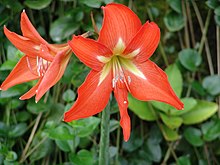| Hippeastrum | |
|---|---|

| |
| Hippeastrum reginae | |
| Scientific classification | |
| Kingdom: | Plantae |
| Clade: | Tracheophytes |
| Clade: | Angiosperms |
| Clade: | Monocots |
| Order: | Asparagales |
| Family: | Amaryllidaceae |
| Subfamily: | Amaryllidoideae |
| Subtribe: | Hippeastrinae |
| Genus: | Hippeastrum Herb.[1][2][3] |
| Type species | |
| Hippeastrum reginae | |
| Subgenera | |
| |
| Synonyms[5] | |



Hippeastrum (/ˌhɪpiːˈæstrəm/)[17] is a genus of about 90 species, and over 600 hybrids and cultivars, of perennial, herbaceous and bulbous plants, native to tropical and subtropical regions of the Americas, from Mexico south to Argentina and on some islands in the Caribbean. The majority have large, fleshy bulbs—usually about the size of a softball—and tall, broad, strap-like leaves that are (generally) evergreen, and large red or purple flowers. Numerous colors and cultivars have been created over the past hundred years.
Hippeastrum is a genus in the family Amaryllidaceae (subfamily Amaryllidoideae, tribe Hippeastreae, and subtribe Hippeastrinae).[18] For many years, there has been confusion among botanists, as well as collectors and the general public, over the generic names Amaryllis and Hippeastrum; the former is a South African genus of plants, while the latter is a new world genus. However, the common name "amaryllis" has been used for Hippeastrum for years, especially for the ornamental cultivars (sold as indoor flowering bulbs around November and December, for Christmas, in the Northern Hemisphere). Within the genus Hippeastrum exist many epiphytic species, as well, which may be found living in natural debris and leaf litter on the crooks of tree branches; by comparison, Amaryllis is a primarily terrestrial, southern African genus of perennial bulbs.
- ^ WCSP 2015, Hippeastrum herb..
- ^ Herbert 1821, Appendix: p. 31, nom. cons..
- ^ Meerow, Van Scheepen & Dutilh 1997.
- ^ Cite error: The named reference
Tropicos-Hippeastrumwas invoked but never defined (see the help page). - ^ WCSP 2015, Synonyms .
- ^ a b c Salisbury & Gray 1866, p. 134.
- ^ Rafinesque 1838, vol. 4, p. 10.
- ^ Link 1829, vol. 1, p. 193.
- ^ Koster 1816, p. 493.
- ^ Salisbury & Gray 1866, p. 135.
- ^ a b Rafinesque 1838, vol. 4, p. 11.
- ^ Cite error: The named reference
WCLSPFLeopoldiawas invoked but never defined (see the help page). - ^ Herbert 1819, p. 5, footnote.
- ^ Herbert 1820, p. 181.
- ^ Rusby 1927, p. 214.
- ^ Plant Life. 7: 41. 1951.
{{cite journal}}: Missing or empty|title=(help)[full citation needed] - ^ Brenzel 2012.
- ^ Stevens 2016.
Cite error: There are <ref group=lower-alpha> tags or {{efn}} templates on this page, but the references will not show without a {{reflist|group=lower-alpha}} template or {{notelist}} template (see the help page).